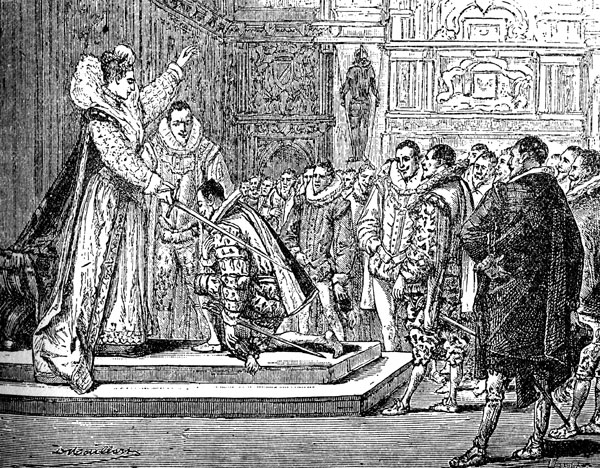 Francis Drake began life as a humble farmer's son, in 1540, Plymouth, England. He grew up to become one of the first sailors to circumnavigate the globe; and his piracy made him feared and loathed along the coastline of Mexico. There he was known as El Draque (The Dragon) for his reign of terror. It was not just ships that he attacked, but towns and cities too.
Francis Drake began life as a humble farmer's son, in 1540, Plymouth, England. He grew up to become one of the first sailors to circumnavigate the globe; and his piracy made him feared and loathed along the coastline of Mexico. There he was known as El Draque (The Dragon) for his reign of terror. It was not just ships that he attacked, but towns and cities too.When he first set sail, in 1567, it was the young Drake who was traumatized. He was aboard his cousin's slave ship, when they were attacked by pirates in the Mexican port of San Juan de Ulúa. After a four-day battle, the English lost all of their human cargo and one ship from their fleet; but Drake and his cousin, John Hawkins, both escaped. Those who had been captured were treated mercilessly by the pirates. Many were dead. It was all too much for Hawkins, who made this is last voyage. But a nautical life was only just beginning for Drake. It was a life filled with hatred towards all Spaniards and all Catholics. Drake was a Protestant; it had been an English Catholic Uprising which had forced his family off their farm, back home in Devon, England. Now it was Spanish Catholic pirates who had attacked their ship. Hawkins and Drake limped back to England in severe hardship, as they hadn't been left adequate rations to make their return voyage. They had dreamed of making their fortune in the slave trade, but now they had nothing. Drake wanted revenge.
Three years later, in 1570, Drake was given a commission by his queen, Elizabeth I, to sail back into the Caribbean and harry Spanish galleons. Hawkins had given him three ships and Drake had hired 70 men as his crew. They descended upon the Spanish colonies, attacked the ships and returned home with a vast wealth in gold and silver. In fact, there was 20 tons of the stuff and that was too much to carry on board their ships. Drake buried what he couldn't fit in his hold, but managed to take back the equivalent of millions of pounds worth. Elizabeth I was thrilled. However, she had just signed a peace treaty with the Spanish and so couldn't openly reward him.
Drake waited until 1577, when the political winds of change meant that he could sail out again with the queen's blessing. This time he took five ships and many more men, with the intention to sail down the coast of Africa before heading towards South America. A mighty storm, at Cape Horn, convinced most of his crew that they wanted to go home, but Drake's own ship carried on. Sailing on the Golden Hinde, Drake and his pirate crew terrorised Chile before heading north.
In 1579, they took a Spanish ship, Manila Galleon Cacafuego, off the coast of Peru. The cargo taken from its hold took four days to transfer to the Golden Hinde and was enough to pay off England's national debt at the time. He returned home in September 1580. Queen Elizabeth I was very pleased with him. She knighted him a year later. Drake immediately bought a manor house and became a member of parliament. His crew received nothing.

Elizabeth I commissioned Drake to sail into the Caribbean and raid all of the Spanish settlements along the coastline. Drake set off in 1585 and destroyed three Spanish towns, in Spain itself, before heading across the Atlantic Ocean. On New Year's Day 1586, the fleet reached Santo Domingo, in the Caribbean, and plundered of 25,000 ducats. They set off again, heading into Cartagena, where 110,000 ducats were taken. Then up to St. Augustine, in Florida (now USA), which was utterly destroyed.
In 1587, Drake was back in Europe. He entered Cadiz Harbour, in Spain, and proceeded to capture and sink 24 Spanish ships. A year later, the Spanish Armada sailed into English waters, in a bid to invade the country. Bad weather and bad luck stopped them. A mighty storm paused them north, always within sight of the coast, but never able to land, as that would mean sailing against the winds. Just when they'd crested the north of Scotland and were able to use the same winds to reach the shore, the weather changed. Now the same strength of storm pushed them south in the opposite direction. Many crashed on the coastline of Ireland. The remainder were harried all the way by an English fleet commanded by Drake. Even in British waters, he was not above piracy. He attacked the Spanish payship, the Rosario, and succeeded in taking off with her wealth.
Drake's piracy continued unabated. He persuaded his cousin, Sir John Hawkins, to return with him into the Caribbean in 1595. There they found that their luck had run out. The Spanish had fortified many of their coastal towns. Then fever struck aboard the ship. Hawkins died first then, on January 27th, 1596, Drake died of fever aboard his ship. His body was thrown overboard into the Caribbean Sea, at Portobelo, Colón, Panama.
* San Juan de Ulúa, Veracruz: The place where Spanish pirates attacked Drake on his first voyage.
* Campeche: Drake raided the town twice during his pirate career.
* Hotel Francis Drake, Campeche: This hotel, named after the infamous pirate, can be found at Calle 12 No. 207 | Entre 63 y 65 Centro, Campeche C.P. 24000 For more information, please visit their website.
* Huatulco, Mexico: A port ravaged by Drake during his pirate days.


No comments:
Post a Comment